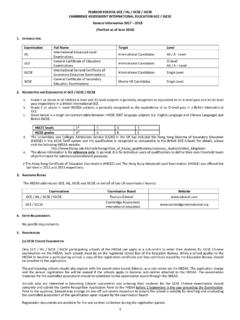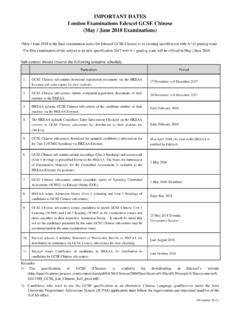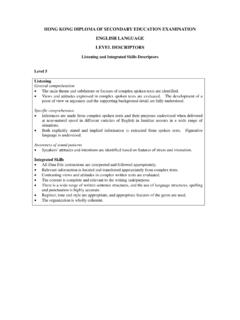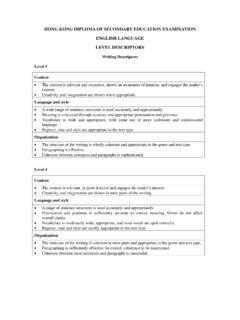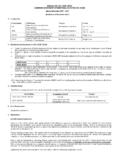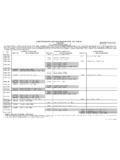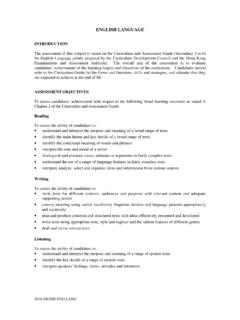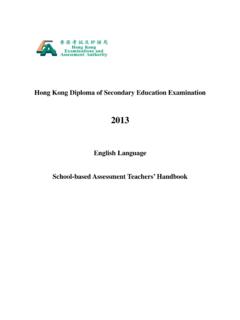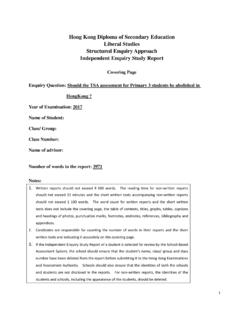Transcription of INTEGRATED SCIENCE PAPER 1 (Sample Paper) Use …
1 Draft as of November 2008. Please stick the barcode label here. HONG KONG EXAMINATIONS AND ASSESSMENT AUTHORITY. HONG KONG DIPLOMA OF SECONDARY EDUCATION EXAMINATION. Candidate Number INTEGRATED SCIENCE PAPER 1 Marker's Examiner's (Sample PAPER ) Use Only Use Only Marker No. Examiner No. Question-Answer Book Time allowed : 2 hours This PAPER must be answered in English. Question No. Marks Marks 1. INSTRUCTIONS. 2. (1) This PAPER consists of questions set on the Compulsory Part of the curriculum. The weighting of 3. this PAPER is 45% of the Subject Mark. (2) Answer ALL questions. Write your answers in the 4. spaces provided in this Question-Answer Book. Do not write in the margins. Answers written in the 5. margins will not be marked. 6. (3) Write your Candidate Number in the spaces indicated on the cover of this Question-Answer 7. Book. 8. (4) Stick barcode labels in the spaces provided on Pages 1, 3, 5, 7 and 9. 9. (5) Supplementary answer sheets will be provided on request.
2 Write your candidate number, fill in the 10. question number and stick a barcode label on each sheet. Tie them loosely but securely with a string Total INSIDE this Question-Answer Book.. Hong Kong Examinations and Assessment Authority All Rights Reserved 2008. 1. Draft as of November 2008. Answer ALL questions. Write your answers in the spaces provided. 1. A simplified map of Country C is shown below. The river provides the major source of fresh water to this country. River marked. Answers written in the margins will not be marked. in the in the margins margins notnot willwill marked. be be (a) The Water Authority of the country noticed that the quality of fresh water supplied to City A and written City B had worsened. written Answers Which city would have high levels of cadmium and zinc, and which city would have a high level Answers of the bacteria, E. coli, in the fresh water supplied to them ? Explain your answer in each case. (4 marks). Answers written in the margins will not be marked.
3 2. Draft as of November 2008. Please stick the barcode label here. 1. (b) The government of this country is debating whether hydroelectric power (HEP) should be developed as an alternative energy source. A proposal has been made to build a dam at site D for the provision of HEP. (i) Give TWO advantages of using HEP over the combustion of fossil fuel in generating electricity. Answers written in the margins will not be marked. Answers written in the margins will not be marked. (ii) Referring to the map, discuss ONE ecological concern and ONE social concern regarding the proposal to build the dam at site D. (6 marks). Answers written in the margins will not be marked. Go on to the next page 3. Draft as of November 2008. 2. It was a hot summer afternoon. The temperature was 35 C and the relative humidity was 75%. Peter just finished all his lessons. He passed by the basketball court and could not resist playing a game with his schoolmates before going home though the hot sun was shining on them.
4 He finished the game at around 5:00 pm. Sweating heavily, he made his 10 minute-walk back home. When he arrived home, he put two cans of soft drinks into the 20 C freezer, turned on his bedroom air-conditioner, and headed for a cold shower. After the shower, he finished a whole can of the chilled soft drink and rested in the air- conditioned room. (a) Explain why sweating can regulate Peter's body temperature. Answers written in the margins will not be marked. Answers written in the margins will not be marked. (2 marks). (b) Identify TWO measures that Peter employed to cool his body down. In each case, briefly explain whether the measure is effective. (4 marks). Answers written in the margins will not be marked. 4. Draft as of November 2008. Please stick the barcode label here. 2. (c) Peter's mother returned home and found her son unwell. Peter told her that he might have got heatstroke when playing basketball under the hot sun. Explain whether Peter's statement is correct or not.
5 (2 marks). (d) When Peter woke up the next morning, he went to the fridge and fetched the other can of soft drink in the freezer. Oh No!', said Peter. What do you think had happened to the can of soft Answers written in the margins will not be marked. drink ? Explain. Answers written in the margins will not be marked. (2 marks). Answers written in the margins will not be marked. 5 Go on to the next page Draft as of November 2008. 3. The diagram below shows a 100 m sprinter in a crouch start position with front and rear feet resting on the starting blocks. front starting block rear starting block The graph below shows the horizontal components of the forces acting on the front starting block and rear starting block after the starting signal. 700. 600. 500. Answers written in the margins will not be marked. force / N. 400. Answers written in the margins will not be marked. 300. 200. 1. rear foot 100. 2. front foot 0. 0 1. time / s (a) It is common nowadays to state Newton's Second Law of Motion in the form of F = ma, where F is the force acting on an object of mass m, and a is the acceleration.
6 Newton stated, in his original work Principia, the Second Law in terms of change in momentum. Express the Second Law in this form. (1 mark). (b) The impulse exerted by the sprinter's foot on the starting block is the change in momentum caused by the total force acting on the block during the time of contact. Find, from the graph, the horizontal impulse exerted by the sprinter's foot on the front starting block. (You are required to show how you arrive at your answer.). (3 marks). Answers written in the margins will not be marked. 6. Draft as of November 2008. Please stick the barcode label here. 3. (c) Suppose that the mass of the sprinter is 60 kg and the horizontal impulse exerted by the sprinter's foot on the rear starting block is Ns. Using your result in (b), calculate the horizontal velocity when the sprinter has just cleared off the starting blocks. (2 marks). (d) Make TWO suggestions to the sprinter which can help improve his performance. Answers written in the margins will not be marked.
7 Answers written in the margins will not be marked. (2 marks). (e) Suggest the sources of energy for powering of the muscle at different times of the 100 m race. (2 marks). Answers written in the margins will not be marked. Go on to the next page 7. Draft as of November 2008. 4. (a) In the early twentieth century, people believed that atoms were like a plum pudding' in which very tiny electrons were embedded in a diffused volume of positive charges. In 1910, Ernest Rutherford and his team carried out an experiment by firing a thin beam of -particles at high speed onto a gold foil. They expected most of the -particles to pass through the foil with little deflection. Out of their expectation, some of the -particles were found to have deflected by angles greater than 90o or even reflected. (i) Sketch a labelled diagram to show the plum pudding' model of a lithium atom. Answers written in the margins will not be marked. Answers written in the margins will not be marked.
8 (ii) Based on the experimental results, Rutherford proposed another model of atom. The diagram below shows Rutherford's model of an atom: atomic nucleus electron Suggest why the above unexpected' experimental results can be explained using Rutherford's model. (6 marks). Answers written in the margins will not be marked. 8. Draft as of November 2008. Please stick the barcode label here. 4. (b) Plotting the logarithm of the successive ionisation energies of an element against the order of removal of electrons can provide information about the electronic arrangement of atoms of the element. The table below lists the logarithmic values of the first eight ionisation energies of element X with atomic number less than 20. Order of removal of electrons 1 2 3 4 5 6 7 8. log10 (ionisation energy) (i) Plot, on the graph below, the logarithm of these eight ionisation energies of X against the order of removal of the electrons. Answers written in the margins will not be marked.
9 Answers written in the margins will not be marked. _____. _____. (ii) Deduce what element(s) may X be. Explain your answer. (6 marks). Answers written in the margins will not be marked. 9 Go on to the next page Draft as of November 2008. 5. (a) State Ohm's law. (1 mark). (b) A student set up the circuit as shown below to investigate the voltage-current relationship across a light bulb. V. A . Answers written in the margins will not be marked. Answers written in the margins will not be marked. The results of the investigation are tabulated, and these data are plotted in the graph below. Voltage / V Current / A current / A. 0. 0 1 2 3 4 5 6. voltage / V. (i) State whether the above results are in agreement with Ohm's law. Justify your answer. Answers written in the margins will not be marked. 10. Draft as of November 2008. 5. (b) (ii) What advice would you give the student in taking measurements so that he would not miss out important information of the current-voltage characteristics of the light bulb ?
10 Explain your answer. (iii) Find the resistance of the light bulb at 2 V and at 5 V. Propose an explanation for any difference in the results obtained. Answers written in the margins will not be marked. Answers written in the margins will not be marked. (7 marks). (c) In a model to account for metal conductivity, a metal is considered to be consisting of positive ions arranged in fixed arrays and the electrons move freely inside the metal. (i) Draw a diagram to illustrate this model. (ii) On the basis of this model, account for the resistance of metals to current flow. (3 marks). Answers written in the margins will not be marked. 11 Go on to the next page Draft as of November 2008. 6. Read the passage below and answer the questions that follow: Ciguatoxin Ciguatoxin is a fat-soluble toxic chemical produced by some algae found in the tropical and subtropical coral reef. When fish feed on the algae, they will get the toxin. The toxin is difficult to be broken down or excreted by the fish.
